How To Write Product Descriptions That Really Sell: 10 Tips
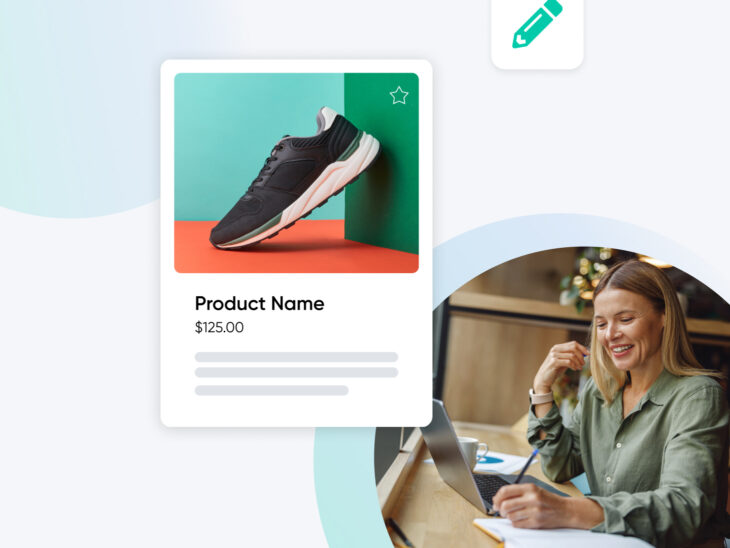
Congratulations! You’ve done the hard website promotion work to lead a potential customer right to your product pages.
But you can’t rest on your laurels quite yet.
As they read through a product description to decide whether or not they will purchase something from your e-commerce business, the million-dollar question arises: Will they buy what you’re selling?
The answer, in large part, depends on how much time and effort you put into your product description.
It may seem drastic to weigh product descriptions so heavily, but research shows that they’re often a decision-making point in the customer journey.
Simply put, users who find sufficient information in a product description are more likely to feel confident and make a purchase.
Those who don’t? They’re more likely to abandon the page or bounce from your site altogether.
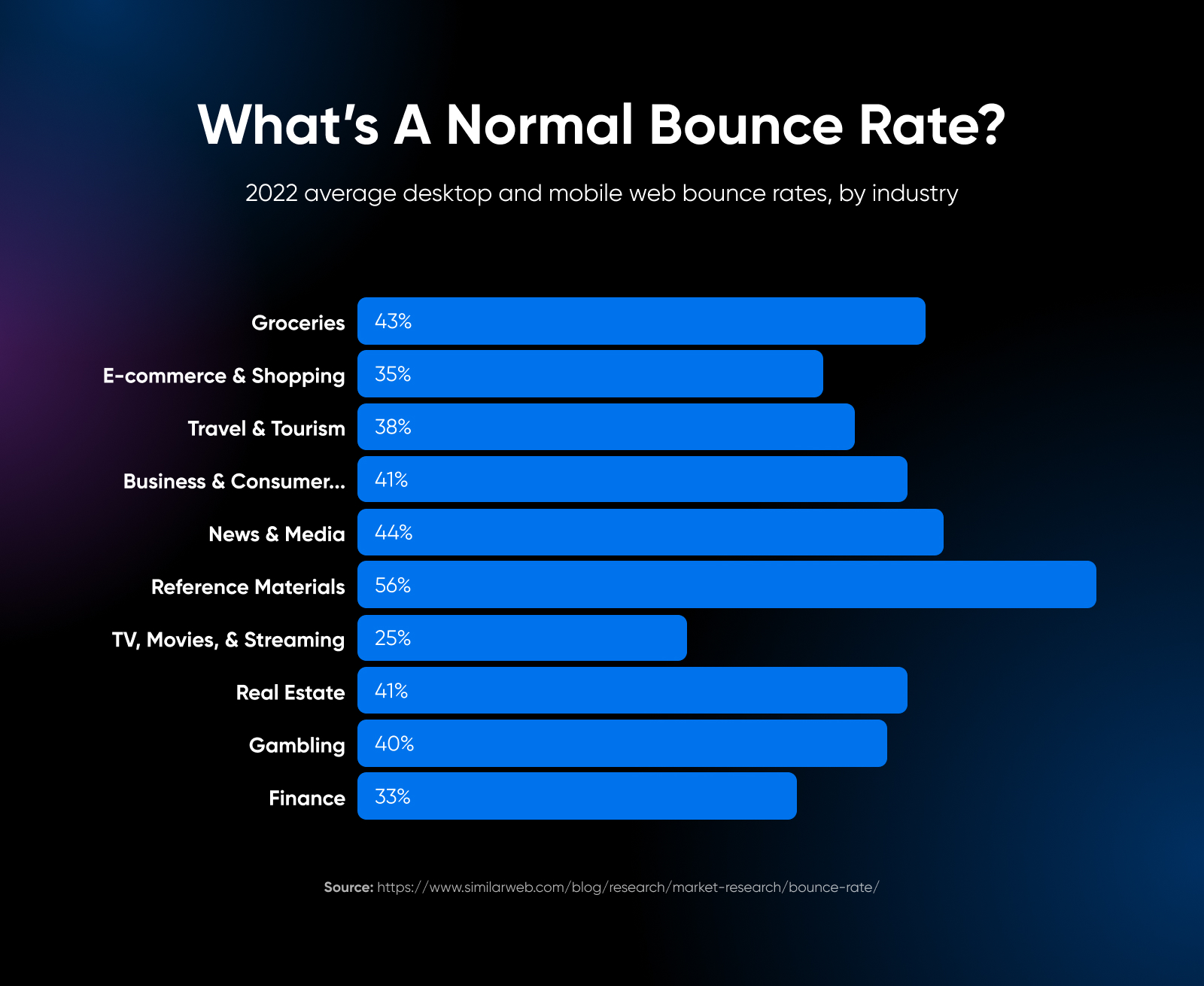
In an online-heavy, post-pandemic world, there are three leading factors influencing how U.S. consumers choose where to shop:
- Delivery options and speed (amen)
- Price (of course)
- The quality of the online images and product description (wow!)
Well-written product descriptions are a critical conversion tool for modern online business websites.
If you want to increase e-commerce sales, it’s time to polish your product descriptions. Let’s talk about how and why.
Why Prioritize Product Descriptions?
Here are just a few of the reasons it’s crucial to consider your product descriptions in e-commerce.
Improve Satisfaction (And Reduce Returns!)
Detailed product descriptions inform customers about each product’s features, uses, and benefits, clarifying their understanding of the product and how it fits their needs.
This can lead to higher customer satisfaction and fewer expensive returns for you due to mismatched expectations.
Improve SEO Performance
Well-optimized product descriptions can seriously improve search engine optimization (SEO) for your e-commerce website. Including relevant keywords, clear product information, and engaging content can enhance your visibility in search results, attracting more organic traffic.
SEO
Search Engine Optimization (SEO) is the practice of improving a site’s ranking in search results. Search results are aggregated based on a number of factors, including a site’s relevance and quality. Optimizing your site for these factors can help boost your rankings.
Read MoreDifferentiate Your Products And Value
A well-crafted product description articulates a product’s unique value proposition, showcasing its benefits and advantages over competitors. This differentiation is key in attracting customers who resonate with the specific advantages your product offers.
Make Sales More Hands-Off
Effective product descriptions guide potential buyers through the sales funnel, transitioning them from curious browsers to motivated buyers. By presenting compelling information, product descriptions encourage users to take the next step and make a purchase. This streamlines the sales process without additional effort from you or your team.
Build Brand Trust
Detailed and accurate product descriptions build trust in not just your offerings but in your overall brand.
When customers have access to comprehensive information about your products that has turned out to be true, they are more likely to trust your brand, leading to repeat purchases and positive word-of-mouth recommendations.
Get Content Delivered Straight to Your Inbox
Subscribe to our blog and receive great content just like this delivered straight to your inbox.
10 Ways To Write An Excellent Product Description
What actually makes a good product description?
In this guide, we’re giving you ten tips (along with winning examples) that provide a comprehensive look into what makes an effective product description.
Let’s go!
(*record scratch* You don’t have an e-commerce site yet? That’s actually not a big deal anymore. Platforms like WooCommerce and Shopify plug seamlessly into a WordPress website to help you handle listing products, posting reviews, shipping goods, and even monitoring store performance metrics. That said, you don’t have to have your website perfectly finished to work on product descriptions. So wherever you are in the process, this guide should still be helpful for you. OK…now let’s go!)
1. Identify Your Buyer Personas
To successfully write about product features that land with your potential buyers, you must know who they are.
This means you need to reference your buyer personas, which are fictional representations of your ideal customers based on market research. If you don’t already have a buyer persona, the time to create one is now.

A buyer persona should answer the following questions:
- What demographic do your ideal buyers belong to?
- What are their interests?
- What is their native language?
- What kind of language appeals to them? (e.g., Does industry jargon appeal to them or turn them off?)
- How do they spend their free time?
- How do they find your website?
- Why are they interested in your store?
If you have the luxury of big data at your hands, collect information on your current customers to also understand:
- Product preferences
- Behavioral patterns
- Purchasing tendencies
Access to this data will help you fine-tune your buyer personas. Once you know who you are selling to, it will be easier to write product descriptions that resonate with them.
2. Focus On Product Benefits And Features
Your buyers don’t head to your page to simply connect. Instead, they come to learn what your product can do and how it will meet their needs and solve their pain points. To help them accomplish this, you need to write an extensive list of your product’s features and benefits.
Start with the features. For example, if you sell shoes, include size information, material, color, the weight of the shoe, etc. Your features section should be comprehensive and tell consumers everything they need to know about what makes your product special.
And while a list of features is a great start, it’s only half the battle. Potential customers also want to know the benefits of your particular product. This is where your product description really starts to shine. Following the shoe example, benefits would include things like comfort, flexibility, odor resistance, wet and dry traction, etc.
Allbirds does a fantastic job of highlighting some of the benefits of their shoes without being verbose. Their key advantages are spelled out in short, sweet blurbs that get right to the point.
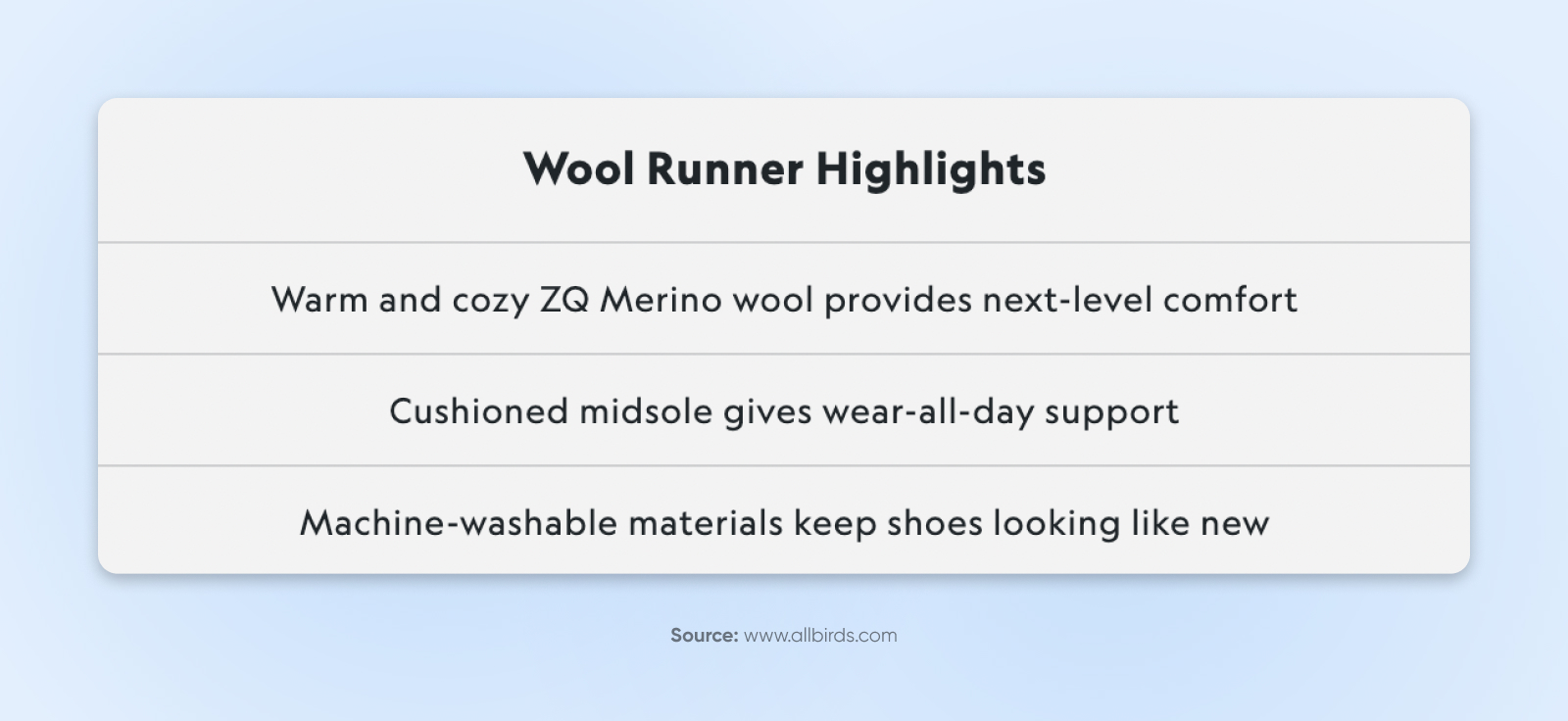
Benefits are your main selling points, your differentiators, and the reasons why customers will select your product over your competitors. Always clearly identify them.
3. Stay True To Your Brand’s Voice
Aligning with your brand’s voice is essential to creating authentic and engaging product descriptions. Your brand’s voice should reflect your personality, values, and style across all communication channels, including product descriptions.
If your brand’s voice is professional, your product descriptions should be professional. If your vibe is funny, then your product descriptions should match.
Most people are familiar with the hilarious Poo~Pourri (now just “~Pourri”) advertising videos (not safe for work!) that launched a $500+ million empire.
They’re memorable in part because ~Pourri has a unique brand identity and tone of voice, which they follow even on their product pages.
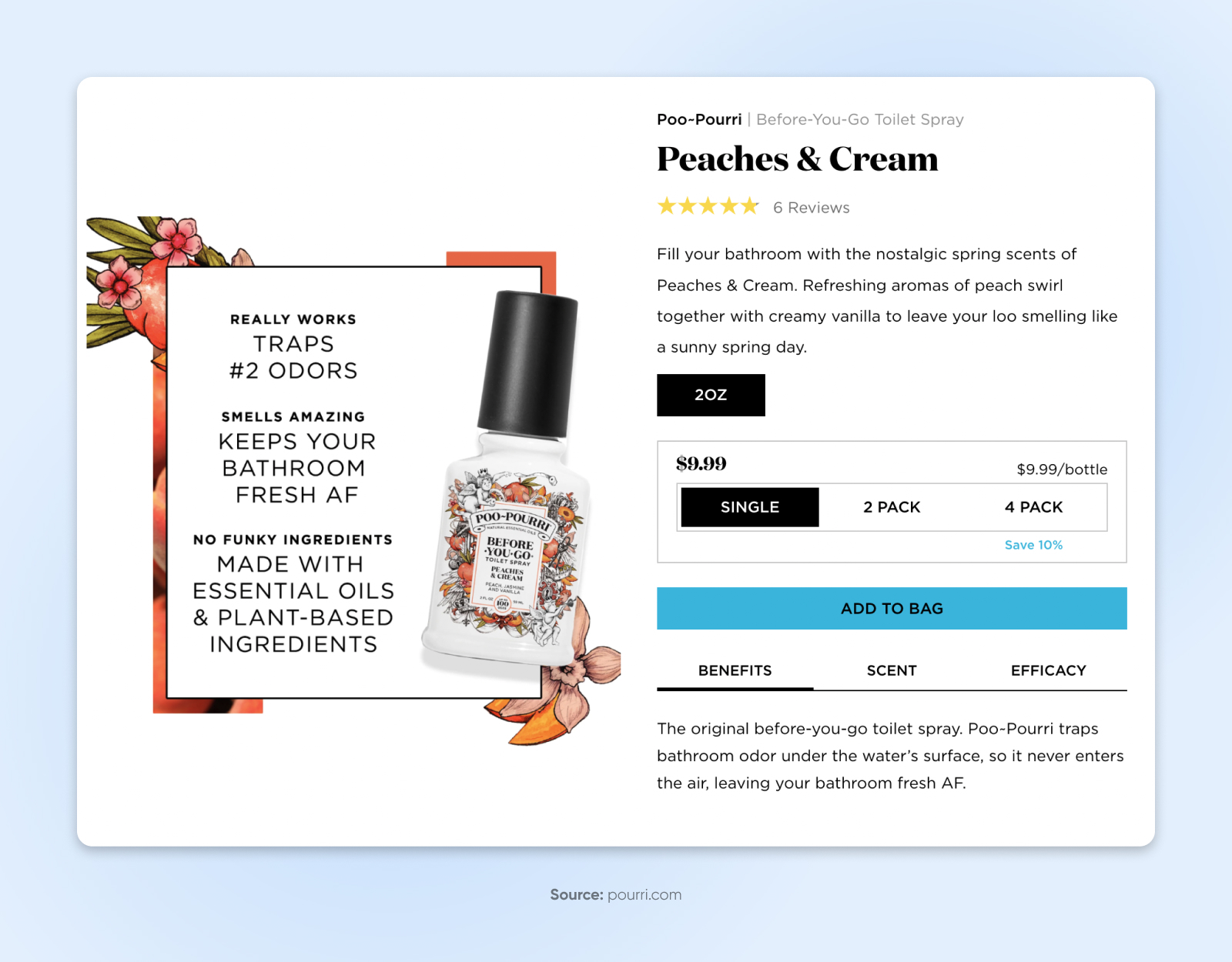
4. Tell A Full Story
Every good story has a solid beginning, middle, and end. Unless, of course, it’s the Game of Thrones television series…but I digress.
With product descriptions, the formula for good writing is no different. You need to present a complete story to engage your readers. This doesn’t mean you need to write a novel, but at the same time, your product description shouldn’t just be a list of features and benefits either.
Instead, show (not tell) your customers how the product will improve their lives. Help them visualize a real-life scenario where your product solves a problem. The goal is to create a narrative arc in which the reader is the hero and your product is the tool that enables them to succeed.
But what if your product isn’t especially photogenic or is *gasp* kind of boring?
People may have once thought that about athletic wear, but I bet no one thinks that when they imagine Nike. Nike’s commercials, brand strategy, and even the way they describe their products transcends the materials to help the reader imagine how their life could change with just this one product.
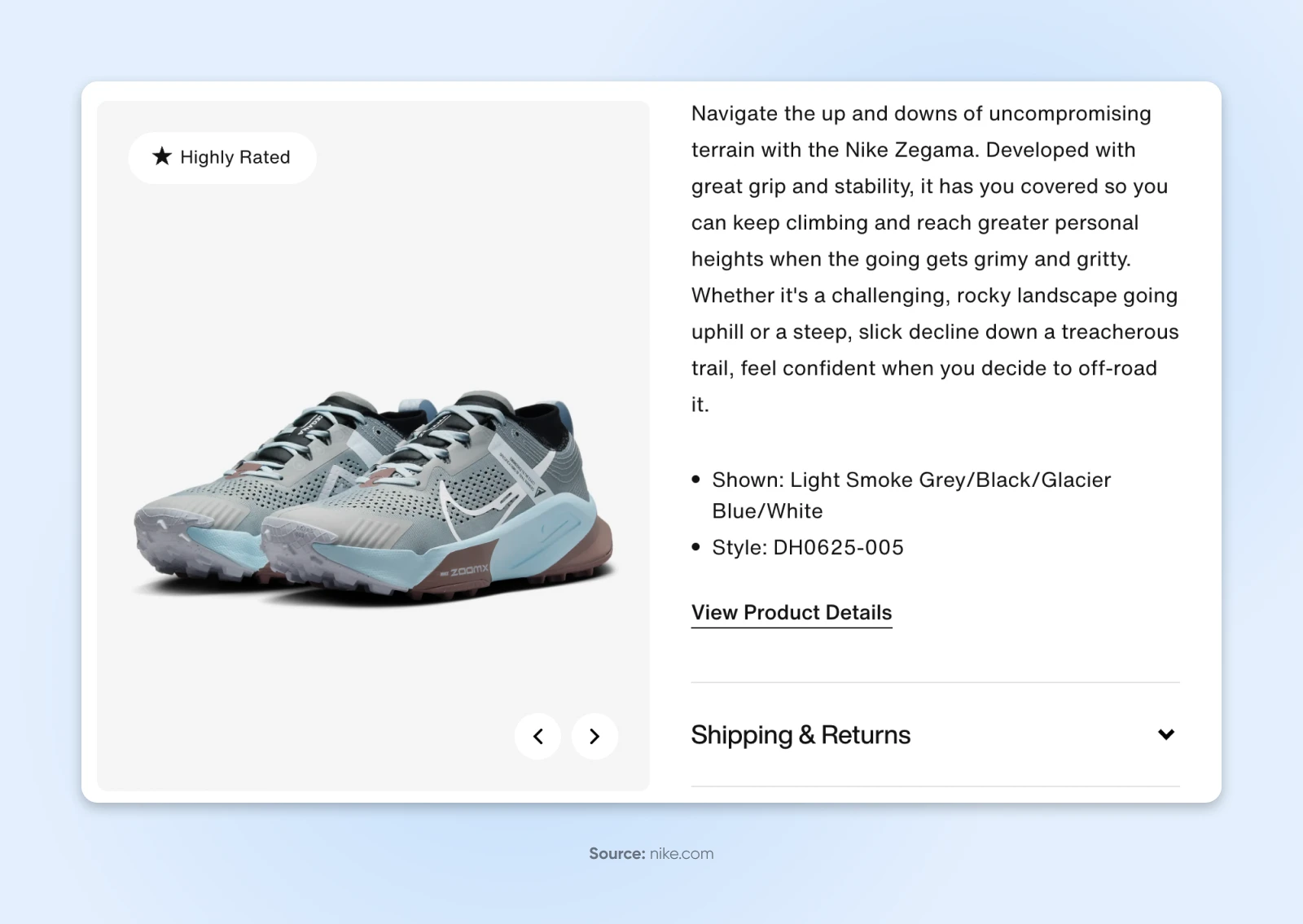
Customers aren’t just buying the shoes — they’re buying the experience, the confidence, the ability to excel. Now that’s a powerful product story.
5. Use Active Language To Persuade Buyers
Your mom was right — The words you use make a difference, especially with product descriptions.
The truth is that some words are more persuasive than others. In fact, experts have tested all kinds of language to come up with 189 words and phrases that actually improve conversion rates.
Consider these 20 tried-and-tested words recommended by David Ogilvy, the proverbial “Father of Advertising”:
- Suddenly
- Now
- Announcing
- Introducing
- Improvement
- Amazing
- Sensational
- Remarkable
- Revolutionary
- Startling
- Miracle
- Magic
- Offer
- Quick
- Easy
- Wanted
- Challenge
- Compare
- Bargain
- Hurry
The common theme? Persuasive words encourage consumers to take action.
Jon Morrow of SmartBlogger has a similar list of power words that tap into your customer’s emotions, making them more likely to engage with your message.
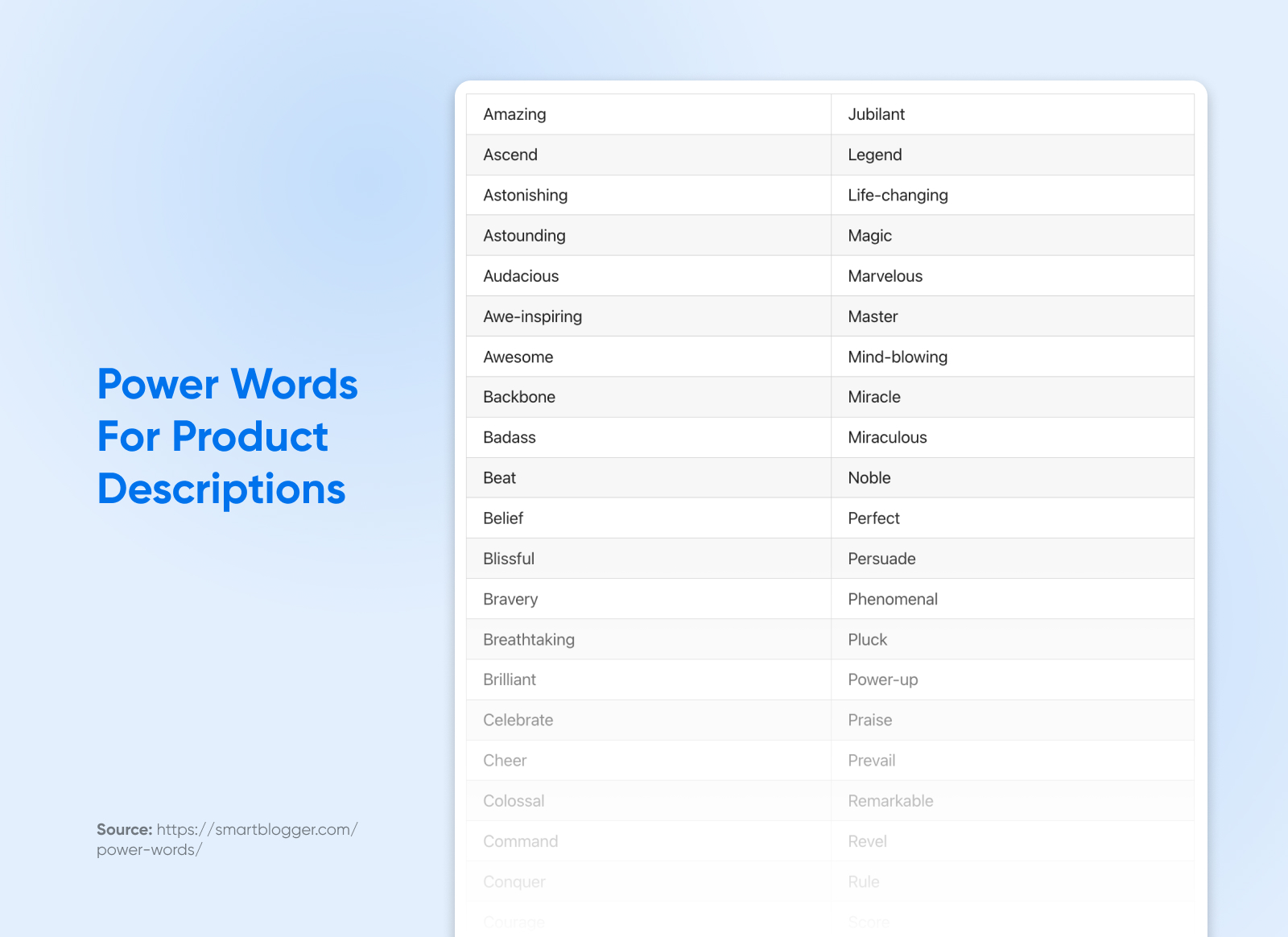
Since many companies use awe-inspiring (see what we did there?) power words in their product descriptions, it’s easy to find good examples, even for seemingly bland products.
Here’s one from Jack Black that utilizes power words to make shaving cream feel swanky.
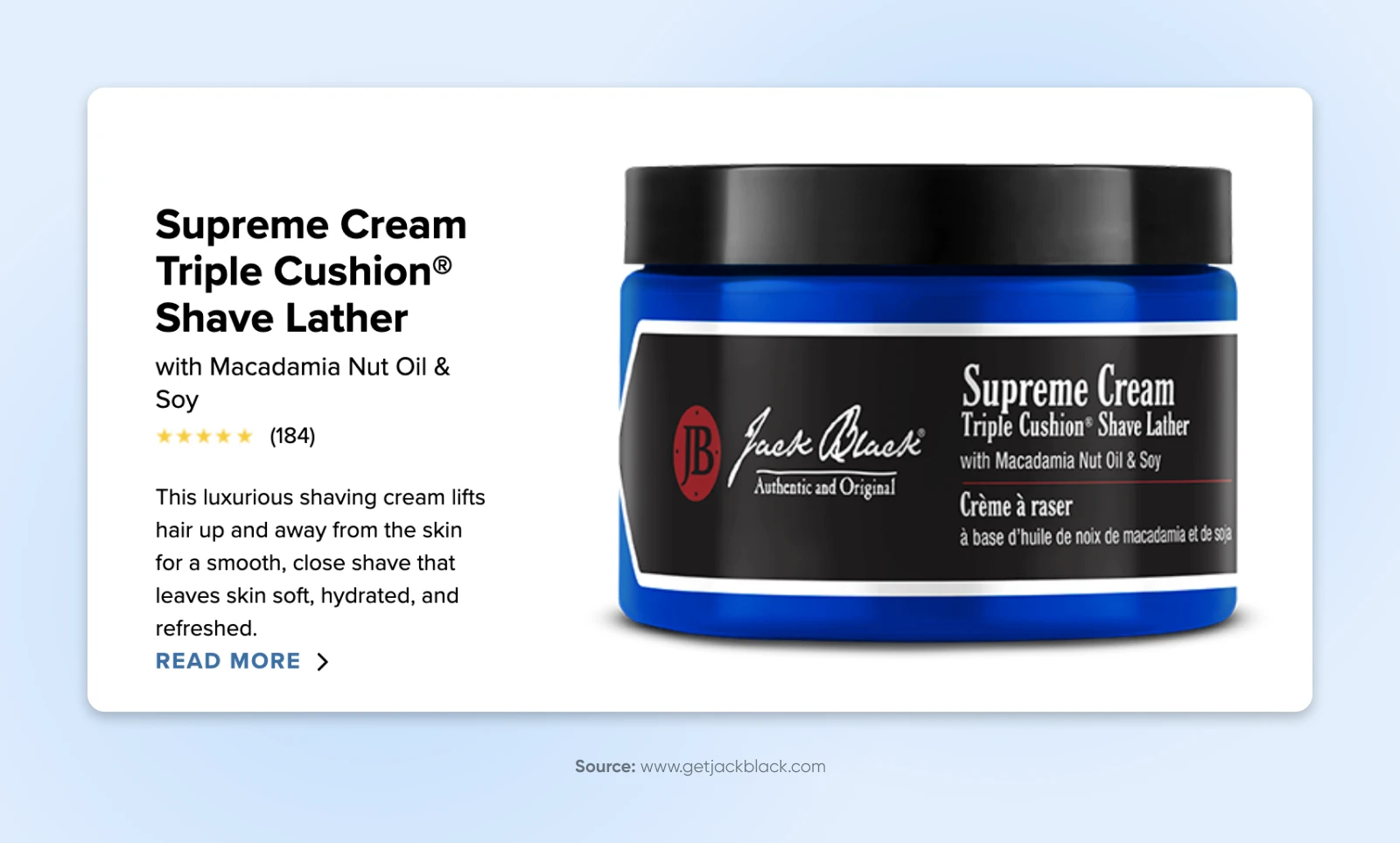
When writing product descriptions, take a moment to scan through your copy and make sure each word pulls its weight.
Related: How To Write An Effective Call To Action
6. Make Text Scannable
Scannability is one of the most critical elements of writing a good product description, especially since attention span is on a downward trend.
This means it’s essential to make your content easily digestible. There are several solutions to packing a narrative punch in a relatively small space:
- Apply headings and subheadings to break content into sections
- Put short snippets of info into bullet points or numbered lists
- Use bold or italicized text to emphasize important phrases
- Keep any paragraphs concise and focused
- Ensure there’s white space between content
- Select a legible font size and on-brand font style
J.Crew does this well. Below an eye-catching headline and a longer description (great for SEO!), they highlight product features in an easily scannable list of bullet points.
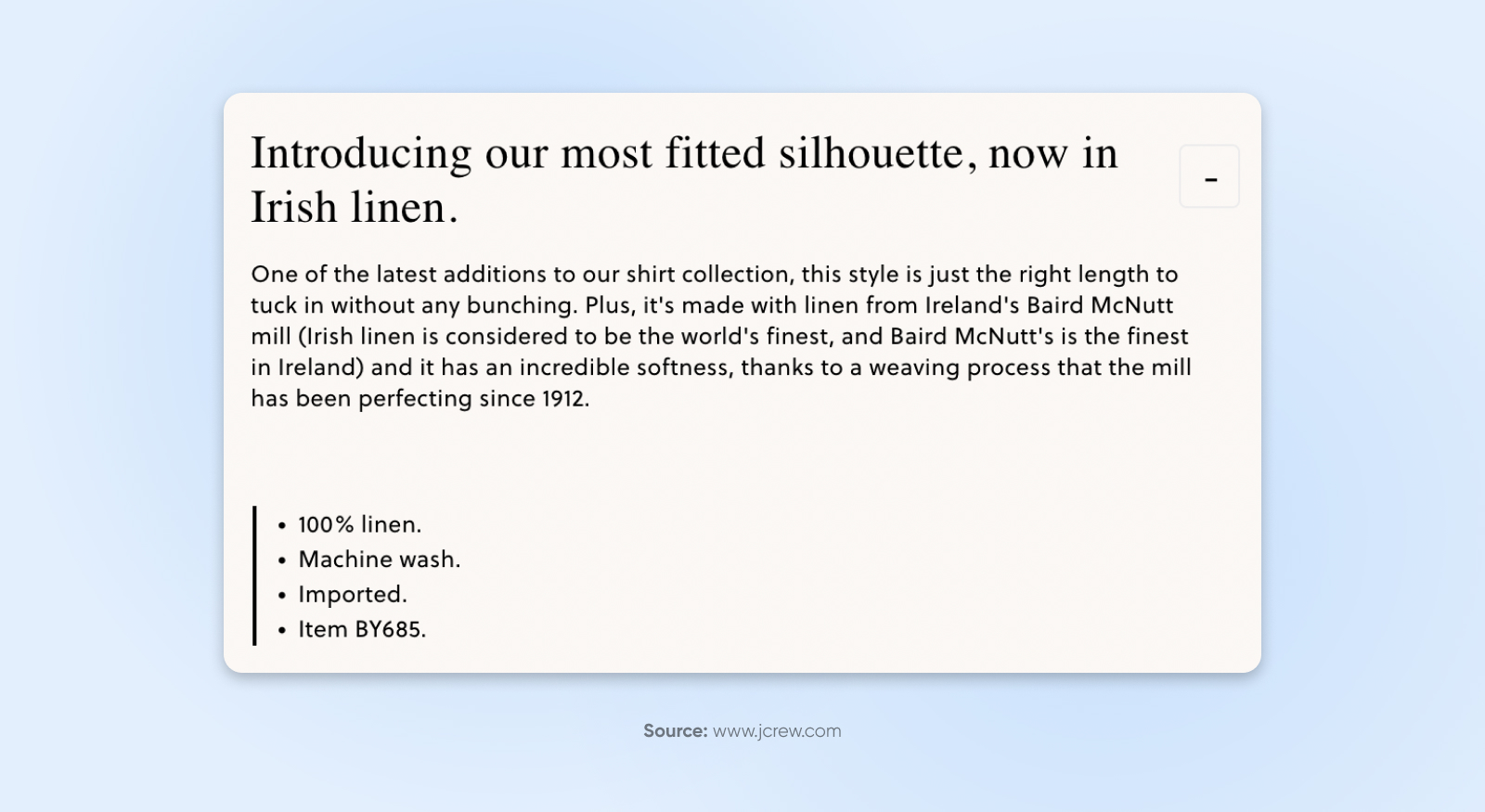
The more you can do to make a product description scannable, the better.
7. Optimize Copy For Search Engines
Copywriters and business owners have a unique challenge when it comes to writing product descriptions. They must persuade readers, but there’s another audience to keep in mind, too: search engine algorithms.
SEO is the practice of applying both on-page tricks (such as using keywords) and off-page tactics (such as a backlinking strategy) to make your website findable via a search engine.
That’s why SEO, including identifying and using the appropriate keywords for your products, should be a critical part of your product description writing process.
Google’s algorithms are constantly changing, so what works one day might not the next. However, some keyword strategies stand the test of time, such as avoiding duplicate content and including target phrases in the following places:
- Page title
- Product title
- Meta descriptions
- Alt tags
- Product descriptions
The keywords you use in your copy help Google and other search engines identify what the page is about. This information is then used to determine how to rank your site on the search engine results page (SERP) so that relevant results are served up to people inputting related search queries.
For example, when you type “shaving cream” into Google, Google displays lots of products.
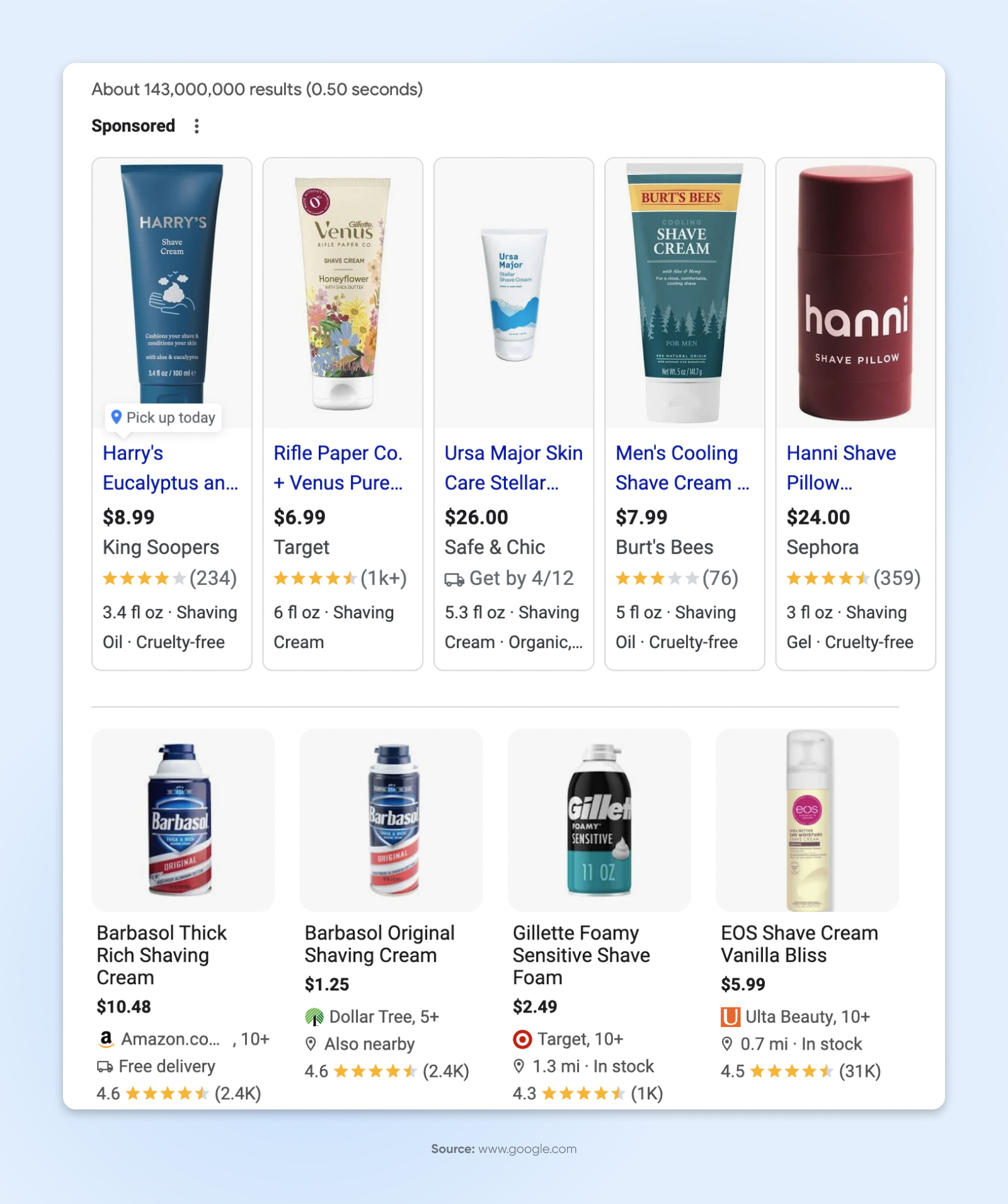
There are literally hundreds of shaving cream products on the market today. Those that show up first have a combination of good advertising and SEO strategies.
Take Cremo Shave Cream, for example. When visiting the landing page for their shaving cream products, it’s clear they have maximized the use of keywords such as shaving cream, shave cream, and shave.
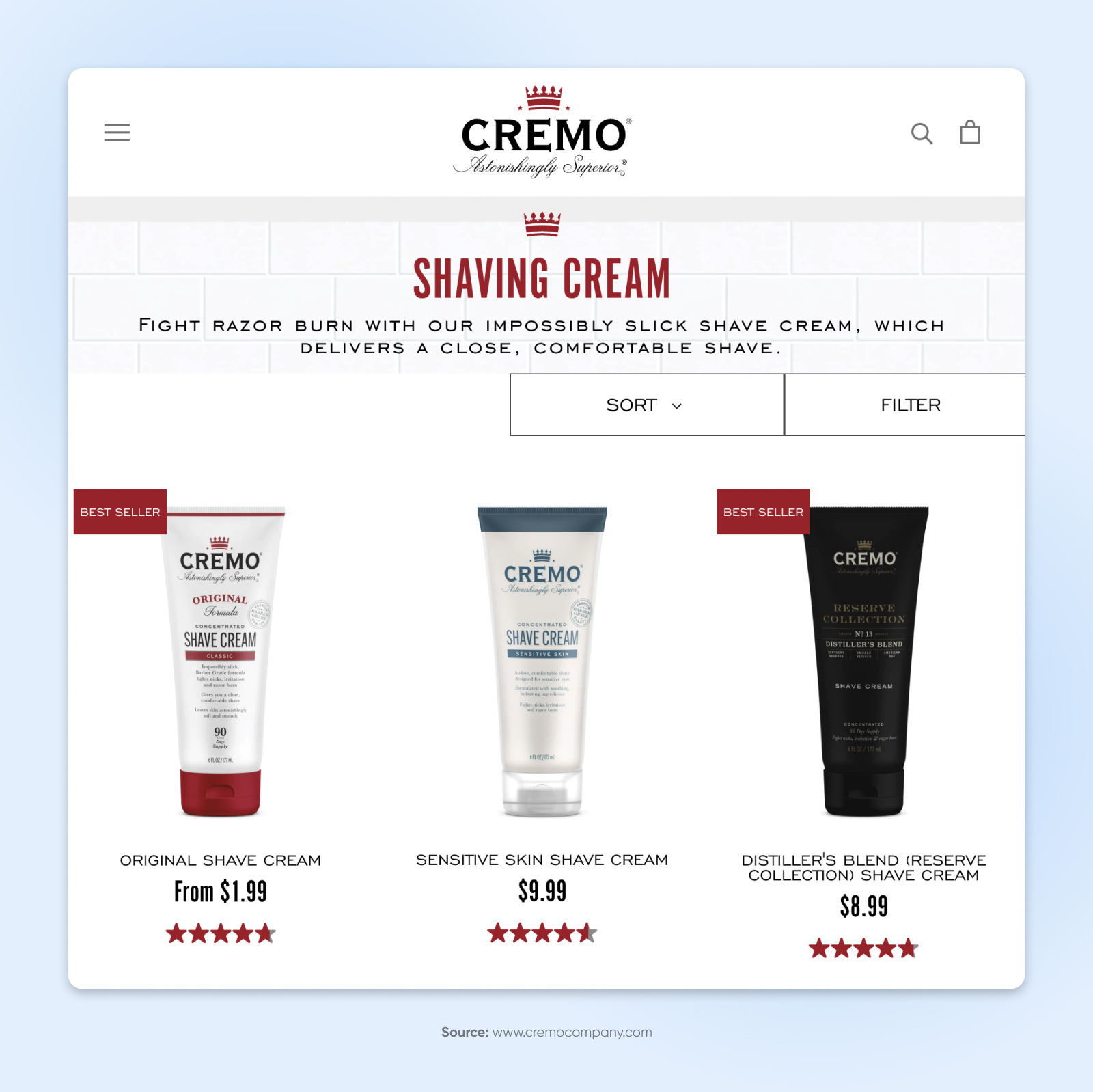
8. Add Images And Video
It should go without saying that a great product description must include images. If you need extra persuasion, remember that Etsy found that 90% of their shoppers rank quality of images as important when making a purchasing decision.
If your e-commerce store can afford to hire a product photographer, awesome! If not, there are plenty of DIY product photography tutorials to help get you started. Of course, good photos start with good equipment, including:
- Camera
- Tripod
- Backdrop
- White bounce cards made of foam board
- Table
- Tape
Once you’ve gathered your gear, you need to know how to take stellar photos, which you can do on a budget with tricks like:
- Setting up a simpler backdrop so it’s easier to touch up images
- Relying on natural light or affordable lighting solutions
- Using a low-cost tripod to steady your camera for clear, detailed shots
Budget even tighter? Pull out the computer in your pocket. If you don’t think a smartphone will do the trick, think again. Hundreds of small brands successfully DIY their product photos on Instagram. Professional photographer Chris Pieta even put together a video to prove that an iPhone 15 Pro can capture great product photos.
Considering that video has the highest ROI of all media formats and short-form video has the best performance among all video types (thanks, TikTok!), it also makes sense to learn how to make these types of videos.
For a corporate example of excellent product photography and awesome videos, iRobot’s Roomba product page features various forms of media to show consumers exactly how each version of their famous vacuum product works.
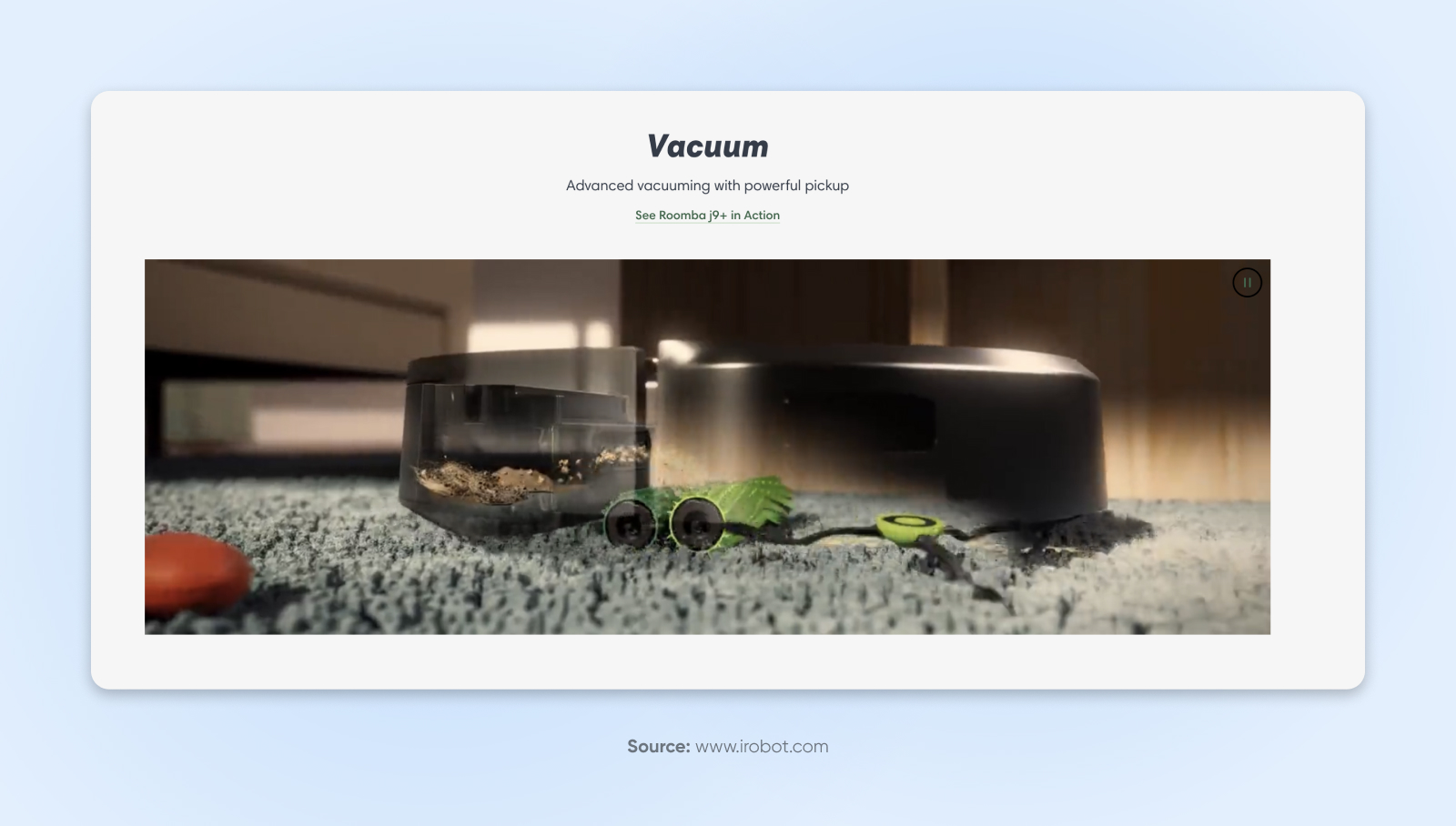
Related: How To Create A Winning Social Media Strategy
9. Incorporate Reviews
In addition to powerful content and beautiful imagery, many successful e-commerce sites use product reviews.
Just like the descriptions you write, customer reviews can emphasize your product’s value and features, help build brand trust, and even boost SEO.
Reviews tap into social proof, which is the phenomenon where people are more likely to participate in something they see others doing. In a marketing sense, content that shows people using and loving your product can spur others to try your product. Reviews are a free way to create this kind of content.
The majority of consumers read reviews before making a purchase, 77% specifically look for websites with reviews, and almost half will walk away from a product if there are no reviews available.
With stats like that, we recommend making sure your e-commerce website has reviewing capabilities. Also, consider creating a program that rewards consumers for reviewing your products once they’ve received them.
Related: 9 Steps To Build An Online Store And Become Your Own Boss
10. Measure And Improve
As we know, the primary goal of a product description is to persuade a shopper to make a purchase. How can you determine if your descriptions are fulfilling this objective? Track their performance by benchmarking and measuring movement on key performance indicators (KPIs).
KPI
‘KPI’ stands for Key Performance Indicator. In SEO, KPIs are metrics used to measure the success of a campaign. KPIs are typically quantifiable data points, such as total organic traffic, conversion rate, or rankings in Google.
Read MoreHere are some common KPIs brands use to monitor how well product content is doing:
- Conversion rate: The percentage of page visitors converted into customers (or leads). This is a good indicator of the power of the content on a product page, and how well it connects to any marketing or advertising that has led shoppers there.
- Cart abandonment rate: The proportion of shoppers who add items to their cart but leave without completing the purchase. High cart abandonment rates may suggest issues with product descriptions, but they can also expose friction in the checkout process.
- Return rate: The percentage of products shipped out that customers return. This metric could indicate discrepancies between product descriptions and the actual products.
- Support inquiries: A high number of queries about a product may signify unclear product descriptions.
Most pre-built e-commerce platforms enable you to track KPIs like these. You can also install Google Analytics and similar third-party tools to do the same.
Finding opportunities for improvement? A/B testing software is a popular method for creating alternate versions of product descriptions and testing them with a subset of your audience to compare performance.
How To Create A Product Description Template
While we’ve just outlined tons of tips for writing product descriptions that really sell, it’s important to note that there’s no one-size-fits-all “best” description. That’s because your offerings likely have different product details, benefits, and selling points.
However, if you have a list of similar products and don’t want to start from scratch every time you write a product description, it can be beneficial to create a template.
Follow the key tactics above to build the core sections of your template by asking:
- What are your buyer personas?
- What are the pain points of your customers?
- How does your product solve customer pain points?
- What power words can you use in your copy?
- Do you have a unique story or brand voice?
- Is your language accessible and free of industry jargon?
- What are the main features and benefits of your products?
- Do you have an image and video library?
Once you’ve addressed each of these questions to create the template outline, you can tweak it for different product types and audiences. Then, keep an eye on performance metrics. If you find a specific layout outperforms others, use that template for other products to grow your brand and revenue.
Help Your E-commerce Site Shine With Reliable Hosting
Only you can revolutionize the way you write product descriptions.
But what if you want to transform how you display them?
It’s critical that you have a functional, well-designed, and always-on website to feature those product descriptions you’ve worked so hard on.
At DreamHost, we offer various affordable website hosting solutions to get your site online — as well as white-glove professional services for website design, development, and even ongoing management and marketing.
Let’s work together to build and run the perfect custom website to make your online store shine.
Your Store Deserves WooCommerce Hosting
Sell anything, anywhere, anytime on the world's biggest eCommerce platform.
